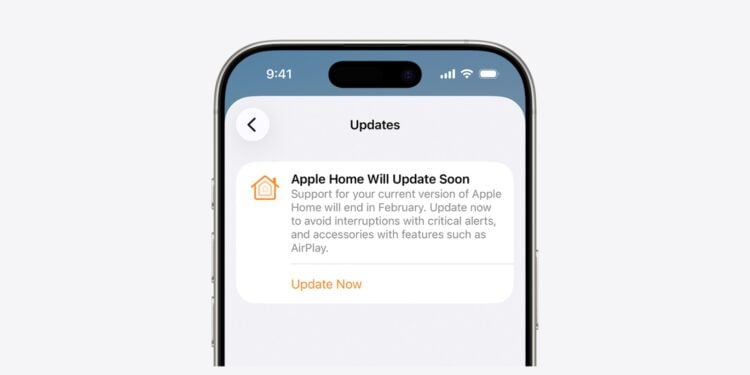Apple has adjusted the timeline for a major change in its smart home system. The previously parallel support for two architectures in the Home app will be discontinued – albeit somewhat later than originally planned. This will change a key aspect of how Apple Home users interact with HomeKit accessories and automations.
The planned end of the old HomeKit architecture, originally scheduled for fall 2025, has been postponed to February 10, 2026. Apple has officially extended the deadline to allow more time for users to transition to the new architecture. The extension applies to all devices using Apple Home, as well as their compatibility with older operating system versions.
Support for legacy HomeKit architecture ends in February 2026
Apple originally announced plans to shut down the old architecture in the fall of 2025. With the updated deadline, the old version will remain active until February 10, 2026. After that date, only the new architecture will be compatible. Users still relying on the old architecture after that date should expect problems with automations and connecting to smart home accessories.
The new architecture was introduced in March 2023 – along with iOS 16.4. Since then, users have been able to choose whether to switch to the new system or stick with the old version. Parallel support for both versions has now been running for over two years. Stability issues that accompanied the launch of the new architecture are now considered resolved.
New minimum requirements for operating systems
With the end of the old architecture, support for older Apple operating systems in conjunction with the Home app also ends. Devices still running older versions will no longer have access to the app starting in February 2026. The new Home app requires at least the following versions:
- iOS 16.2
- iPadOS 16.2
- macOS 13.1
- tvOS 16.2
- watchOS 9.2
All devices with earlier versions will then lose their connection to the Home app and can no longer be used to control HomeKit accessories.
Features and benefits of the update
The new architecture brings with it not only an improved technical basis but also several new features:
- Support for guest access to give others temporary access to the smart home.
- Integration of robot vacuum cleaners into the home app
- Activity history for greater transparency in processes and access.
- Faster and more stable control – especially in complex environments with many HomeKit or Matter devices.
Apple particularly emphasizes that the new architecture is designed for larger smart home setups and works significantly more reliably.
This is how the update is performed
The upgrade can be initiated directly via the Home app. Simply go to the "More" section, open "Home settings," and then look for the new architecture under "Software update.".
Those who do not install the update manually may be automatically switched to the new architecture. Explicit consent may not be required.
- iOS 26.1 closes over 50 dangerous security vulnerabilities.
- iOS 26.1 now available: What's in the new update
- iPhone update search failed? How to solve the problem
Apple draws a clear line with the Home app
The extended deadline provides more time to plan the transition to the new HomeKit architecture. Nevertheless, the update will become mandatory in February 2026 if the Home app is to continue functioning without limitations. Devices with older system versions will lose access, and the old architecture will no longer be supported. The new version offers enhanced features, improved performance, and greater stability – especially for large smart home installations. (Image: Apple)
- New intro for Apple TV: Finneas reveals details
- Apple launches App Store for the web
- Apple TV shows new intro with music by FINNEAS
- Apple launches creative Christmas project in London
- Apple confirms: No new Macs planned for 2025
- Apple stock: Wedbush raises price target to $320
- Apple stock: TD Cowen significantly raises price target to $325
- Apple stock: Evercore raises price target to $300
- Apple stock: JP Morgan raises price target to $305
- No chat monitoring: EU foregoes chat surveillance
- Apple in leak dispute: New details about Prosser and Ramacciotti
- WhatsApp is testing its own app for the Apple Watch
- Apple Q4 2025 Overview – Facts from the Conference Call
- Apple experiences sales boom: iPhone 17 exceeds expectations
- Apple struggles with tariffs: Billions in costs in the Christmas quarter
- Apple confirms: Redesigned Siri will be released in 2026
- Apple aims for record sales during the Christmas season
- Apple Q4 2025: Record revenue and strong profit growth
- China and the USA: No real peace in the trade dispute
- Bank of America raises price target for Apple to $320





